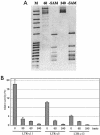CpG methylation directly regulates transcriptional activity of the human endogenous retrovirus family HERV-K(HML-2)
- PMID: 15613316
- PMCID: PMC538560
- DOI: 10.1128/JVI.79.2.876-883.2005
CpG methylation directly regulates transcriptional activity of the human endogenous retrovirus family HERV-K(HML-2)
Abstract
A significant proportion of the human genome consists of stably inherited retroviral sequences. Most human endogenous retroviruses (HERVs) became defective over time. The HERV-K(HML-2) family is exceptional because of its coding capacity and the possible involvement in germ cell tumor (GCT) development. HERV-K(HML-2) transcription is strongly upregulated in GCTs. However, regulation of HERV-K(HML-2) transcription remains poorly understood. We investigated in detail the role of CpG methylation on the transcriptional activity of HERV-K(HML-2) long terminal repeats (LTRs). We find that CpG sites in various HERV-K(HML-2) proviral 5' LTRs are methylated at different levels in the cell line Tera-1. Methylation levels correlate with previously observed transcriptional activities of these proviruses. CpG-mediated silencing of HERV-K(HML-2) LTRs is further corroborated by transcriptional inactivity of in vitro-methylated 5' LTR reporter plasmids. However, CpG methylation levels do not solely regulate HERV-K(HML-2) 5' LTR activity, as evidenced by different LTR activities in the cell line T47D. A significant number of mutated CpG sites in evolutionary old HERV-K(HML-2) 5' LTRs suggests that CpG methylation had already silenced HERV-K(HML-2) proviruses millions of years ago. Direct silencing of HERV-K(HML-2) expression by CpG methylation enlightens upregulated HERV-K(HML-2) expression in usually hypomethylated GCT tissue.
Figures





References
-
- Abrink, M., E. Larsson, and L. Hellman. 1998. Demethylation of ERV3, an endogenous retrovirus regulating the Kruppel-related zinc finger gene H-plk, in several human cell lines arrested during early monocyte development. DNA Cell Biol. 17:27-37. - PubMed
-
- Akopov, S. B., L. G. Nikolaev, P. P. Khil, Y. B. Lebedev, and E. D. Sverdlov. 1998. Long terminal repeats of human endogenous retrovirus K family (HERV-K) specifically bind host cell nuclear proteins. FEBS Lett. 421:229-233. - PubMed
-
- Barbulescu, M., G. Turner, M. I. Seaman, A. S. Deinard, K. K. Kidd, and J. Lenz. 1999. Many human endogenous retrovirus K (HERV-K) proviruses are unique to humans. Curr. Biol. 9:861-868. - PubMed
-
- Boese, A., M. Sauter, U. Galli, B. Best, H. Herbst, J. Mayer, E. Kremmer, K. Roemer, and N. Mueller-Lantzsch. 2000. Human endogenous retrovirus protein cORF supports cell transformation and associates with the promyelocytic leukemia zinc finger protein. Oncogene 19:4328-4336. - PubMed
Publication types
MeSH terms
LinkOut - more resources
Full Text Sources
Other Literature Sources

